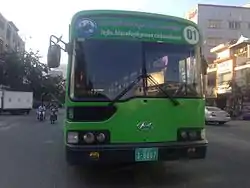Transport in Phnom Penh
The city of Phnom Penh is served by multiple transport systems including public buses, private taxis and ride-hailing via mobile apps.
Phnom Penh is connected to the rest of the country through the national roads as well as by domestic flights to and from Phnom Penh International Airport.
The Municipality of Phnom Penh is largely responsible for overseeing the public transport in Phnom Penh.
Roads
Road-based transport is the primary source of transport in Phnom Penh. It consists of taxis, tuk tuks and private transportation.
Buses
| Phnom Penh City Bus | |
|---|---|
 logo of the Phnom Penh City Bus | |
 | |
| Overview | |
| Locale | Phnom Penh, Cambodia |
| Transit type | bus rapid transit |
| Number of lines | 16 [1] |
| Daily ridership | 7000 [2] |
| Operation | |
| Began operation | September 2014 |
| Operator(s) | Phnom Penh Municipal Government |
| Number of vehicles | 235 buses |
| Technical | |
| System length | n/a |
As of 2020, the public bus transportation in Phnom Penh consists of 17 lines:
| Line | Terminus | Opened | Distance (km) |
Frequency (mins) |
|---|---|---|---|---|
| 1A | Bus Depot ↔ Boeng Chhuk | October 2018 | 20.0 | 10-15 |
| 1B | Boeng Chhuk ↔ Prince Manor Resort | October 2018 | 10.6 | 20-30 |
| 2 | Kouch Kanong Roundabout ↔ Prek Samrong Bridge | October 2018 | 18.0 | 10-15 |
| 3 | Freedom Park ↔ Borey Santepheap 2 | January 2018 | 23.1 | 10-15 |
| 4A | Freedom Park ↔ Borey Santepheap 2 | January 2018 | 20.1 | 20-30 |
| 4B | Freedom Park ↔ Ang Snoul | October 2018 | 28.7 | 10-15 |
| 4C | Freedom Park ↔ Prek Kampoes Commune Hall | October 2018 | 20.5 | 20-30 |
| 5A | Bus Depot ↔ Aeon Mall Sen Sok | October 2018 | 13.0 | 20-30 |
| 5B | AEON Mall Phom Penh ↔ AEON Mall Sen Sok | October 2018 | 16.2 | 15-20 |
| 6 | Kouch Kanong Roundabout ↔ Bus Depot | October 2018 | 20.2 | 15-20 |
| 7 | Kilometer No 9 ↔ Boeung Chhouk | October 2018 | 21.7 | 20-30 |
| 8 | Kouch Kanong Roundabout ↔ St. 2004 Terminal | October 2018 | 16.0 | 20-30 |
| 9 | Borei Santepheap 2 ↔ Ang Snoul | January 2018 | 19.5 | 15-20 |
| 10 | St. 2004 Terminal ↔ Chba Ampov Market | October 2018 | 14.5 | 20-30 |
| 11 | Sleng Pagoda ↔ Stueng Meanchey Intersection | October 2018 | 14.0 | 20-30 |
| 12 | Cambodia Railway ↔ Cambodia Railway (Loop) | October 2018 | 8.9 | 20-30 |
| 13 | Cambodia Railway ↔ Deum Thkov Market Roundabout | October 2018 | 6.6 | 20-30 |
Since 2014, air conditioned buses have run along three main bus routes across the city, managed by the Phnom Penh Municipal Government and formerly sponsored by the Japanese International Cooperation Agency. Line A travels north/south along Monivong Boulevard going around Wat Phnom (stop 21), the Central Market (stop 30) and near the Tuol Sleng Genocide Museum (Stop 41), Olympic Stadium (stop 37), the Royal Palace and the National Museum of Cambodia (stop 35). Line B serves the western side along Mao Tse Tung Boulevard, going much further south to Ta Khmao, capital of the Kandal Province near the Choeung Ek Genocidal Centre. Line C goes east/west Phnom Penh along the Russian Confederation Boulevard to Phnom Penh International Airport BRT station. The fare for the public buses is KHR1500 per voyage irrespective of distance. Students and senior citizens travel free as of 2015.
Public transport operates between 5:30am to 8pm.
Phnom Penh City Bus will be use BYD electric bus that are currently in operational test.
Taxis
Taxis appear in the form of cars, motorcycles, and tuk-tuk. Motorcycle taxis are a common and unregulated form of public transport, common in Phnom Penh.
Ride-hailing via mobile apps has become a popular mean of transportation within Phnom Penh. After acquiring Uber, Grab has become the largest ride-hailing service in Phnom Penh and Siem Reap, offering car, tuktuk and motorbike services. A local based ride-hailing app, PassApp is also widely used in Phnom Penh.
Rail
The only form of rail transport in Phnom Penh is the airport shuttle train operated by Royal Railway. The journey from Phnom Penh International Airport to the city centre, and vice versa takes under 40 minutes. The airport train first began service on 10 April 2018.[3]
In 2016, the Cambodian government announced that they were getting assistance from Japan International Cooperation Agency (JICA) to conduct a feasibility study on an AGT system in Phnom Penh.[4] The study began in 2017 and was completed and submitted to the Ministry of Works and Public Transport in 2019.[5]
Separately, in 2019, the government has also awarded contracts to two Chinese firms to conduct feasibility studies on both a metro and a light rail system.[6]
Airports
Phnom Penh is served by Phnom Penh International Airport, the largest airport in terms of land area in Cambodia.
A new larger international airport is being built at Kandal province, south of Phnom Penh and will replace the existing airport once fully completed.[7]
See also
References
- "Phnom Penh City Bus".
- "City says bus system loses $100K a month".
- "Phnom Penh airport shuttle train launched". Railway Gazette. Retrieved 22 February 2020.
- "JICA Moots City Transit System". Khmer Times. 4 August 2016.
- "Study on mass transit system completed". Khmer Times. 10 July 2019.
- "Feasibility studies for monorail and metro system started". Khmer Times. 11 April 2019.
- "New Phnom Penh Airport cost estimated at $1.5 billion". Khmer Times. Retrieved 22 February 2020.